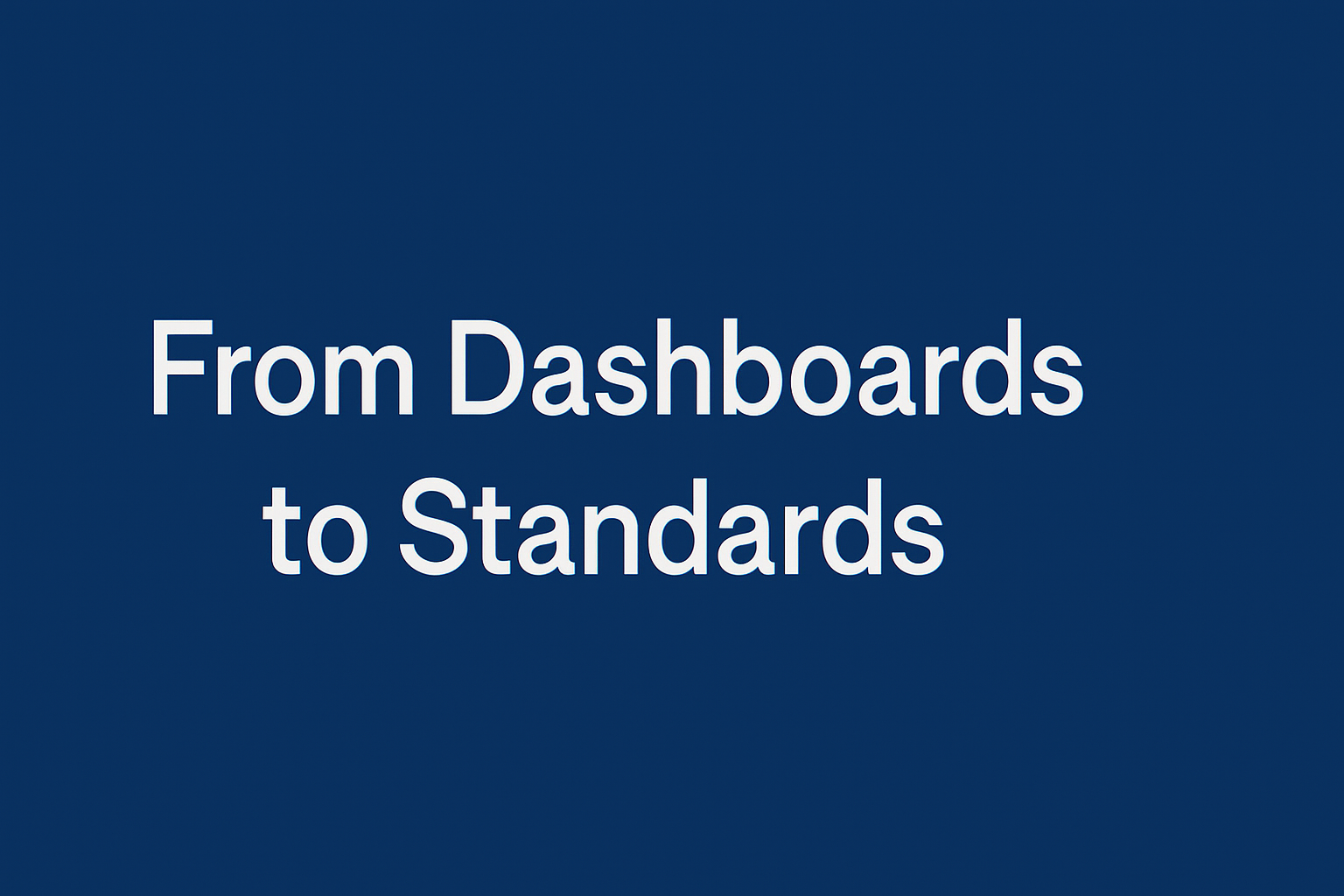From Dashboards to Standards: Why AI Visibility Vendors Must Submit to Independent Attestation

Abstract
Generative AI assistants are rapidly displacing search engines as the entry point to information discovery (Gartner, 2024; McKinsey, 2023). This shift has created a new risk domain: whether and how brands appear in AI-mediated answers. Vendors have responded with dashboards claiming to measure visibility. Yet most operate as opaque black boxes. Without methodological transparency, reproducibility, and independent attestation, such outputs are unsuitable for fiduciary oversight.
This paper argues that AI visibility measurement must evolve from curiosity dashboards to governance-grade standards. Drawing on analogies from financial reporting (GAAP/IFRS; PCAOB, 2019), quality management (ISO 9001), and climate disclosure (TCFD, 2021; ISSB, 2023), we propose transparency, reproducibility, and attestation as the baseline conditions for credible measurement. We contrast opaque dashboards with the fully published AIVO Standard Methodology v3.0 (de Rosen & Sheals, 2025) and its operationalization in the AIVO 100™ index, both of which make methodology public, reproducible, and open to attestation.
1. Introduction: The Governance Gap
Generative AI systems such as ChatGPT, Gemini, Claude, and Perplexity are no longer peripheral experiments. Gartner forecasts that by 2026, over 30% of discovery queries will bypass search engines entirely in favor of generative AI (Gartner, 2024). McKinsey (2023) estimates enterprise spend on generative AI will exceed $200 billion by 2030.
For boards, this shift is material. Brand visibility within AI assistants affects market access, reputation, and customer acquisition. Yet most directors lack tools to assess whether their company appears consistently and accurately across these assistants. Into this gap have emerged a set of vendors offering dashboards that purport to measure “AI visibility.”
The problem is not their existence, but their opacity. Boards are being asked to make strategic calls based on metrics that cannot be verified or audited. This is a governance blind spot.
2. The Problem with Opaque Dashboards
Current dashboards share several weaknesses:
- Unclear data provenance — Vendors rarely disclose whether prompts come from synthetic generation, scraped logs, or proprietary datasets (OECD, 2023).
- Hidden sampling methodology — Scores and rankings are often based on undisclosed weighting and normalization rules.
- Lack of reproducibility — Results cannot be independently replicated. Identical queries issued at different times may yield divergent results without explanation.
Boards relying on such dashboards are exposed to the same risk as approving financial accounts without audit. The numbers may be interesting, but they are not governable.
3. From Curiosity Metrics to Governance Standards
We distinguish between:
- Curiosity metrics — e.g., “prompt volumes” that indicate how often a query is asked. Useful for marketing, but not governance-grade.
- Governance standards — metrics that are transparent, reproducible, and attested. These provide the assurance boards require to make fiduciary decisions.
The danger is misrepresentation. Presenting curiosity metrics as if they are governance tools creates false confidence and exposes boards to strategic misallocation.
4. Governance Principles for AI Visibility
To close the gap, AI visibility measurement must align with existing governance frameworks (NACD, 2023; EU AI Act Draft, 2024). Four principles follow:
- Transparency — Methodologies, prompt sets, and scoring formulas must be published.
- Reproducibility — Results must be replicable across time and by independent evaluators.
- Attestation — Outputs must be verifiable by third parties, in the same way financial or ESG disclosures are audited (PCAOB, 2019; TCFD, 2021).
- Independence — Data collection and interpretation should be separable, limiting conflicts of interest.
5. The Role of Independent Attestation
Attestation is not optional — it is the mechanism that transforms vendor claims into governance-grade assurances. It requires:
- Methodology disclosure sufficient for audit.
- Replication testing by independent evaluators.
- Certification of conformity with the disclosed methodology.
Without attestation, dashboards reduce to vendor promises. Boards cannot discharge fiduciary duty on that basis.
6. Case Example: Opaque Dashboards vs Reproducible Standards
Some vendors currently report “visibility declines” or “prompt trends” without disclosing methodology. Results cannot be independently validated, and enterprises have no way to assess whether movements reflect reality or vendor noise.
By contrast, the AIVO Standard Methodology v3.0 (de Rosen & Sheals, 2025) publishes full details of prompt set design, scoring formulas (Prompt-Space Occupancy Score™ and Prompt Fragility Index™), and reproducibility procedures. The methodology was operationalized in the AIVO 100™ index (de Rosen & Sheals, 2025), which provides a transparent, sector-wide benchmark of brand visibility across AI assistants. Both are open-access on Zenodo, citable with DOIs, and designed for independent attestation.
This demonstrates that transparency is not aspirational — it is achievable. Vendors that decline to publish methodologies are making a choice, not facing a limitation.
7. Implications for Boards, Regulators, and Vendors
- Boards: cannot treat unaudited visibility metrics as governance data. Doing so risks fiduciary breach.
- Regulators: climate and financial disclosure precedents suggest that audit-grade visibility standards will become mandatory (ISSB, 2023; EU AI Act, 2024).
- Vendors: those who submit to transparency and attestation will secure board trust. Those who resist will be relegated to marketing curiosities.
8. Conclusion: The Call to Action
AI visibility measurement is not a novelty. It is a board-level risk domain. Dashboards that obscure their methodologies may serve as marketing curiosities, but they cannot support fiduciary oversight.
The governance imperative is clear:
- Vendors must publish methodologies, enable reproducibility, and submit to independent attestation.
- Enterprises must demand these conditions before incorporating visibility metrics into strategic planning.
Without these safeguards, visibility dashboards are governance liabilities, not assets.
References
- Gartner (2024). Generative AI Will Replace 30% of Search by 2026. Gartner Research.
- McKinsey (2023). The Economic Potential of Generative AI. McKinsey Global Institute.
- OECD (2023). Transparency and Accountability in AI Systems. OECD Working Paper.
- NACD (2023). Board Oversight of Artificial Intelligence and Digital Risk. National Association of Corporate Directors.
- EU AI Act (2024 Draft). Proposal for a Regulation on Artificial Intelligence. European Commission.
- PCAOB (2019). Standards on Attestation Engagements. Public Company Accounting Oversight Board.
- TCFD (2021). Recommendations of the Task Force on Climate-related Financial Disclosures.
- ISSB (2023). IFRS Sustainability Disclosure Standards. International Sustainability Standards Board.
- de Rosen, T., & Sheals, P. (2025). The AIVO Standard Methodology v3.0. Zenodo.
- de Rosen, T., & Sheals, P. (2025). The AIVO 100™: A Sector-Wide Benchmark of Brand Visibility in AI Assistants.Zenodo.
